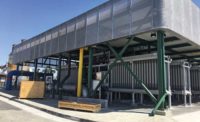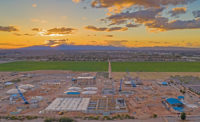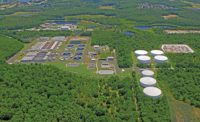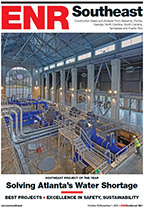Terminal Island Water Reclamation Plant Advanced Water Purification Facility Expansion
Los Angeles
Region ENR California
Water/Environment
Project Team
Owner LA Sanitation
Design Firm/Civil/Structural/MEP Engineer Bureau of Engineering-Environmental Engineering Division
General Contractor Walsh Construction Co.
Project Engineer Carollo Engineers Inc.
The design-build Terminal Island Water Reclamation Plant expansion project, featuring high-tech water-purifying treatments, was a study in complexity. The expansion required collaboration with multiple agencies, contractors, suppliers and academic partners to house and support an oxidation process that uses ultraviolet light and chlorine bleach to purify the water.
The new oxidation method was selected after Terminal Island’s year-long pilot study found it less expensive and more environmentally friendly than the traditional UV-based oxidation process using hydrogen peroxide. It also eliminates the need to pull leftover hydrogen peroxide from the water after treatment.
The expansion doubles the plant’s capacity, providing up to 12 million gallons of water per day. Los Angeles Sanitation will use a portion of that recycled water to shield the local groundwater system from seawater intrusion and use the rest for irrigation, industrial uses and to augment a nearby lake. The Terminal Island expansion was the first large-scale wastewater design-build project for the City of Los Angeles, says project manager Blayne Goodman at general contractor Walsh Construction.
“There were so many moving parts, so many players involved,” says Michael Sarullo, division engineer at the Bureau of Engineering-Environmental Engineering Division. “We were instituting new technologies never used before, and because this water leaves the facility and is used around the city, we had partnerships with the many different groups.”
The team’s partner agencies included the city’s Dept. of Water and Power, the Water Replenishment District and the Division of Drinking Water. The team also coordinated with vendors to test equipment, technical systems and vital components such as the membranes used to filter water, Sarullo says.
The new process required a facility for the UV light system as well as a 2-million-gallon equalization tank, says Adam Zacheis, vice president at Carollo Engineers Inc. The water is first treated through microfiltration, then with reverse osmosis using plastic membranes and finally via the facility’s UV reactor. The project team built canopies with perforated stainless-steel panels to protect the microfiltration and reverse-osmosis modules from sun and rain.
“The biggest challenge was that it’s a very tight space,” Zacheis says. “The microfiltration, reverse osmosis and reactors are pretty much crammed into that small site. There were challenges running utilities; we kept finding buried utilities that weren’t supposed to be where they were.”
The expansion project was completed on 2.5 acres of the plant’s 21-acre site, says Walsh project superintendent Brian Bjornson. Existing facilities and roads crowded the area reserved for the new 2-million-gallon concrete tank with 28-ft-high walls.
“We had to build it from the inside,” Bjornson says. “Once we poured the foundation, we put the crane inside and built the walls, leaving one section open so we could pull it out.”
The Bureau of Engineering developed 60% of the project’s design before putting the facility expansion out to bid, Sarullo says, with the design-build phase taking two and a half years. The team also adopted a modular design, with the modules fabricated off site. This allowed site and foundation work to be completed at the same time as module fabrication, and the modules arrived at the site preassembled, tested and electrically wired.








Post a comment to this article
Report Abusive Comment